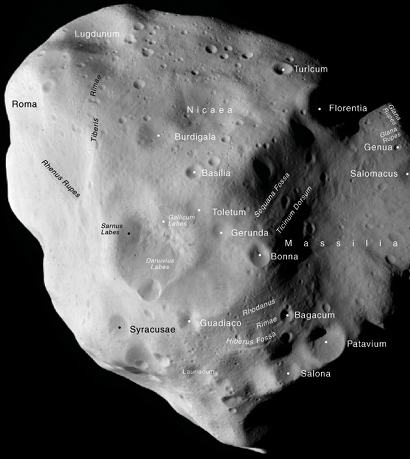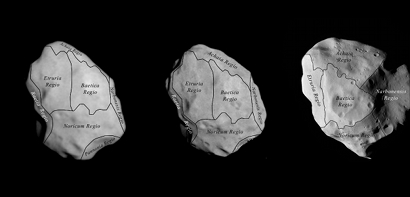|
Antimatter Man
Join Date: May 2004
Location: that interweb thing
|
Asteroid updates:
Vesta rocked by mighty impacts
Quote:
The scale of the pummelling Asteroid Vesta has taken through its history is starting to become clear.
Analysis of data returned by the orbiting Dawn spacecraft shows this giant rock took a mighty double beating in its southern polar region.
One impact had long been recognised from images of the asteroid acquired by the Hubble telescope.
But Dawn's measurements indicate that Vesta was also hit much earlier in time in almost exactly the same location.
These two major impacts gouged out depressions hundreds of kilometres in diameter, and sent shockwaves rippling around the body.
Scientists are fairly confident that the deep system of troughs extending around Vesta's equator and northern hemisphere are fractures that opened up in the surface as a direct consequence of the southern bombardments.

Images from Dawn reveal grooves parallel to Vesta's equator. They cover 240 degrees of longitude
"We can see some things in the visual imagery of Vesta, but it's only when you get in close enough to map the topography that other features come to light," said Debra Buczkowski from the Applied Physics Laboratory at Johns Hopkins University in Baltimore, US.
"And when we did this it was like 'woah! - there's another impact basin there'.
"We simply didn't know of its existence until we had the topography," she told BBC News.
'Impressive' peak
Craters on the asteroid are being named after the vestal virgins - the priestesses of the goddess Vesta - and famous Roman women.

Before Dawn, our best image of Vesta was supplied by the Hubble Space Telescope
In that vein, the biggest crater at the south pole has been called Rhea Silvia, the mother of Romulus and Remus.
The impact depression measures some 475km in diameter, and gives Vesta the look of a punctured football in Hubble pictures.
Since Nasa's Dawn spacecraft arrived at the asteroid in July, scientists have been able to examine the basin's key features in detail.
It has a central mountain that would have formed when rock that had been depressed in the impact rebounded upwards.
The peak's height is impressive - it rises about 22km (13 miles) above the surrounding terrain, making it more than twice as high as Mount Everest here on Earth.
This much has been clear now for several weeks, but as Dawn has circled closer in to the asteroid it has been able to get better and better information on the surface shape of Vesta.
An analysis of this data has shown that Rhea Silvia actually overlies another, older impact basin that is only marginally narrower in extent - about 375km across.

Better information on surface shape (topography) reveals that Rhea Silvia sits on top of an older impact crater. Rhea Silvia itself may be 2.5 billion years old. The equatorial trough system is also visible in this image.
... continues ...
|
---
Asteroid 21 Lutetia had a molten metallic core
Holy primordial planetesimals, Batman!
Bring on the asteroid miners!
Quote:
Spacecraft casts new light on asteroid's history
New findings suggest the giant rock may be a remnant of the early solar system

Could this be the battered face of a planet that never was? Photograph: AFP/Getty
A battered asteroid that was intercepted and surveyed by a European spacecraft last year may be the ancient remains of a planet that never formed, scientists say.
Fresh analysis of measurements taken from the European Space Agency's Rosetta probe found evidence that beneath the cracked and cratered exterior of asteroid 21 Lutetia was a molten, metallic core.
The findings, if confirmed, suggest the giant rock is a "planetisimal", a remnant of the early solar system that represents a snapshot of planetary development, rather than a fragment of a larger asteroid or a cosmic pile of rubble.
The Rosetta probe swung by the speeding asteroid in July 2010 at a distance of 282 million miles from Earth. At the time, Lutetia was the largest asteroid to have been visited by a spacecraft.
Close-up images of Lutetia revealed a surface scarred with large cracks and impact craters, evidence of the asteroid's long and battered history. The lump of space rock measured 121km long, 101km tall and 75km wide.
Infrared cameras aboard Rosetta found the surface temperature of the rock never exceeded -19C. Further measurements of the asteroid's density surprised scientists, because they suggest that the asteroid's interior has a dense, metallic core.
Benjamin Weiss, a planetary scientist at Massachusetts Institute of Technology who was involved in the study, said a molten core within Lutetia might indicate "hidden diversity" within the broader asteroid belt. "There might be many bodies that have cores and interesting interiors that we never noticed, because they're covered by unmelted surfaces," he said. "The asteroid belt may be more interesting than it seems on the surface."
If Weiss is right, Lutetia is a case of arrested development. The asteroid may have grown large enough to develop and retain a melting core, but then avoided the larger collisions that drive planet formation. It would be the first asteroid known to be partially differentiated, that is having a melted interior overlain by cooler layers. An international team of researchers describe the findings of the Rosetta fly-by in three papers published in the journal Science.
The spacecraft has flown past a number of asteroids since its launch in 2004 en route to the comet 67P/Churyumov-Gerasimenko in 2014. On arrival, Rosetta will release a small lander onto the icy comet and spend the next two years orbiting the asteroid as it heads towards the sun.

Images (from left to right) taken 60, 30 and 3 minutes prior to closest approach showing the different regions of asteroid (21) Lutetia.
... continues ...
|
^ Click links in the Guardian story above for the ESA pages and status updates
Not your average 'roids. Or maybe we just need to reevaluate what average interplanetary pebbles can be. 
All those who believe in telekinesis, raise my hand.
Last edited by curiousuburb : 2011-10-30 at 20:33.
|
|
|
quote
|